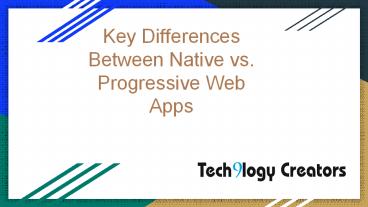Key Differences Between Native vs. Progressive Web Apps - PowerPoint PPT Presentation
Title:
Key Differences Between Native vs. Progressive Web Apps
Description:
Stuck with choosing between Native vs. Progressive Web Apps? This article will help you grasp the difference between Native vs. Progressive Web Apps and pick your right option. – PowerPoint PPT presentation
Number of Views:76
Title: Key Differences Between Native vs. Progressive Web Apps
1
Key Differences Between Native vs. Progressive
Web Apps
2
Key Differences Between Native vs. Progressive
Web Apps
3
If you ask mobile users, they just need two
things in their mobile app- high performance and
small size. And currently, only two methods fit
in the needs of users. First, the Native web apps
and the second one is the Progressive web apps.
However, nowadays there is a debate about, which
one is the better one of these two
methods. If you are the one whos puzzled on
choosing from the apps, you have to know these
apps first. And to know more about the native web
apps, lets dive deep, scroll down.
4
What is Native Web Apps- native web apps are for
specific mobile systems such as androids and iOs
users. Have a look at the pros and cons of native
web apps.
5
The Pros of Native Web Apps- Fast performance -
The app is developed for a certain platform, so
it showcases the high-performance quality on
those particular platforms. The app is already
stored in devices, so it wont take much time to
load, which boosts the performance of the
app. Better security- it feels secure while
using native web app because it follows all the
rules and guidelines of Google, AppStore and
playstore. Access to in-build device features-
It has full access to the functionality of
devices such as GPS, Camera, NFC etc. The access
gives an advantage of showcase its connectivity.
6
Interactive with other apps- it can interact with
other apps, means you can connect with
third-party apps easily. Geofencing- means, you
can use the core operating system. So users can
get a push notification after approaching the
location.
7
The Cons of Native Web Apps- Distribution
friction- It is a well-known fact that users
dont download the app easily. It has become more
difficult to attract users with native
apps. Only work on one platform- In the case of
native app, you have to develop it from each
platform, as its platform-specific. Demands
more money and time- Because of low-level
programming, its time-consuming and not so
pocket-friendly as well. Difficult to update
You have to upgrade it every time you have to go
through the same review system.
8
What is the Progressive Web Apps- The app built
with the latest web app technology such as HTML,
CSS3, Javascript. Have a look at the pros and
cons of progressive web apps.
9
The Pros of Native Web Apps- Easy to install
and launch (accessibility)- The add to home
screen feature of PWA, makes it easy to
install and launch. No app store difficulties-
The app is independent of the app store, so you
dont have to struggle with the app downloading
and uploading. Up-to-date- It always gets
updated, when you are online, So you dont need
to worry about the updates. Low development
cost- It is a single device for all platforms,
which ultimately make it a low-cost device.
.
10
SEO Optimization- The URLs of PWA helps Google
to read the website on search engines, which
help in SEO Optimization at the end.
.
11
The Cons of Progressive web Apps- Missing the
app store traffic- The app is missing the huge
users-traffic, who directly install the apps from
the Google play store and other app
stores. High-battery uses- The app is written in
high-level web code, which means high-battery
uses. Features restriction- Since, PWA is not a
full app, there are some functionality
limitations. The features such as no access to
calendars, alarms, contact and browsers bookmarks
etc. No indoor Geolocation- It cant access
Bluetooth like indoor geolocation.
12
Limited browser support- It does not support
all browsers, such as the big brand like
safari browser, as the browser is android-centric.
To sum it up, when you read the article wisely,
you will notice that it completely depends on
your business demands and budget. Native and
progressive both have their advantages and
disadvantages. So whoever you choose as your
web app method, we can help you with our expert
team of web app developers for both.































